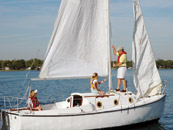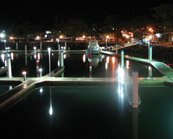When it’s time to weigh anchor (retrieve the anchor), a windlass can make the job a whole lot easier.
A windlass is a mechanical device, usually located near the center of the foredeck (the deck, or flat part of the boat near the front) that grasps the anchor rode (rode: line or chain that attaches the anchor to the boat), pulls it out of the water, and deposits the line/chain either on the deck or below decks in a special compartment.
Think of a winch on the front of a boat trailer—crank the handle to pull the boat out of the water. The difference between a winch and a windlass is that the line wraps around and around the cylindrical portion of a winch; whereas the line goes into the forward end of the windlass, passes around the gypsy (cylinder/drum/pulley) and exits out the back (or bottom) of the windlass housing.
The shaft of a horizontal windlass is situated, as the name implies, horizontally, while the shaft of a vertical windlass is positioned vertically.
A manual windlass uses your muscle power to operate the mechanism—simple, and very traditional, but a lot of work, especially if the anchor is heavier than a couple cases of your favorite canned beverage.
On the other hand, a power windlass uses electricity (or hydraulics, on mega yachts and ships), rather than the sweat of your brow, to do the job. It’s easy—press a button and the anchor goes up, push a button and the anchor drops—very cool.


